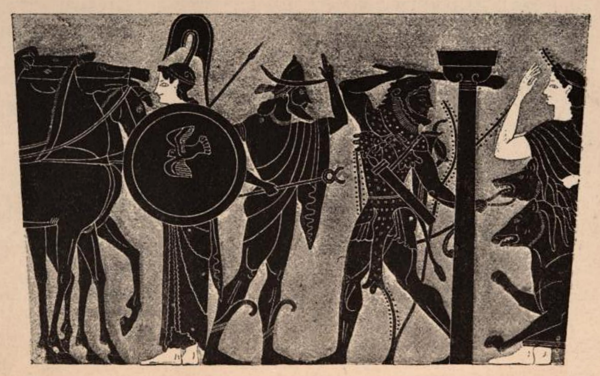Transcriber's Note: This text contains several words in Greek. If the Greek symbolsdo not display properly your browser may not have a compatible font. All Greekwords will display a transliteration on mouse-over.

Explanation of Frontispiece
The picture is reproduced from Baumeister's Denkmäler des klassichenAlterthums, volume I., figure 730 (text on p. 663). It is on a vase anddescribes one of the twelve heroic deeds of Herakles. The latter,holding aloft his club, drags two-headed Cerberus out of Hades by achain drawn through the jaw of one of his heads. He is just about topass Cerberus through a portal indicated by an Ionic pillar. To theright Persephone, stepping out of her palace, seems to forbid the rape.Herakles in his turn seems to threaten the goddess, while Hermes, to theleft, holds a protecting or restraining arm over him. Athene, withaverted face, ready to depart with her protégé, stands in front of fourhorses hitched to her chariot. Upon her shield the eagle augurs thesuccess of the entire undertaking.
Cerberus,
The Dog of Hades
The History of an Idea
BY
MAURICE BLOOMFIELD
Professor of Sanskrit and Comparative Philology
Johns Hopkins University
CHICAGO
The Open Court Publishing Company
LONDON
Kegan Paul, Trench, Trübner & Co., Ltd
1905
Copyright 1905
by
THE OPEN COURT PUBLISHING CO.
Chicago
To the Memory
of
F. Max Müller
CERBERUS, THE DOG OF HADES
Hermes, the guide of the dead, brings to Pluto's kingdom their psyches,"that gibber like bats, as they fare down the dank ways, past thestreams of Okeanos, past the gates of the sun and the land of dreams, tothe meadow of asphodel in the dark realm of Hades, where dwell thesouls, the phantoms of men outworn." So begins the twenty-fourth book ofthe Odyssey. Later poets have Charon, a grim boatsman, receive thedead at the River of Woe; he ferries them across, provided the passagemoney has been placed in their mouths, and their bodies have been dulyburied in the world above. Otherwise they are left to gibber on thehither bank. Pluto's house, wide-gated, thronged with guests, has ajanitor Kerberos, sometimes friendly, sometimes snarling[Pg 2] when newguests arrive, but always hostile to those who would depart. Honey cakesare provided for them that are about to go to Hades—the sop toCerberus. This dog, nameless and undescribed, Homer mentions simply asthe dog of Hades, whom Herakles, as the last and chief test of hisstrength, snatched from the horrible house of Hades.[1] First Hesiod andnext Stesichorus discover his name to be Kerberos. The latter seems tohave composed a poem on the dog. Hesiod[2] mentions not only the namebut also the genealogy of Kerberos. Of Typhaon and Echidna he was born,the irresistible and ineffable flesh-devourer, the voracious,brazen-voiced, fifty-headed dog of hell.
Plato in the Republic refers to the composite nature of Kerberos.[3]Not until Apollodorus (2. 5. 12. 1. ff.), in the second century B. C.,comes the famili